In the Studio: Hieroglyphic Being
Jamal Moss is a minimalist. Not necessarily in the music he makes under his esoteric […]
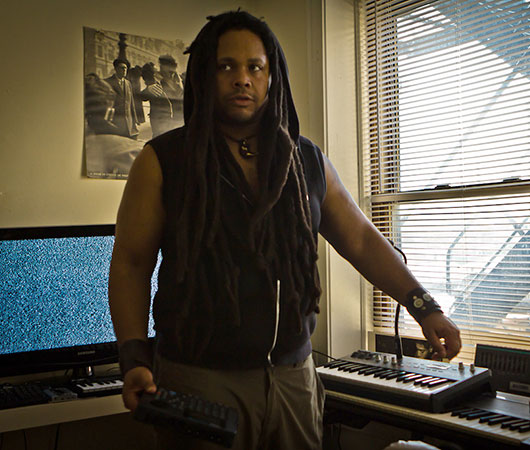
Jamal Moss is a minimalist. Not necessarily in the music he makes under his esoteric Hieroglyphic Being guise, but in the way he lives and works. Considering that he lives in his studio—or rather, that his studio is also his home—he keeps things simple. There’s a bed, a kitchen, a TV, and his gear. We visited his Evanston apartment/studio just north of Chicago, and noticed that this minimalism extends beyond furniture and decorations. It also applies to the equipment he uses to make his sprawling techno, house, ambient, and noise productions. Not one to chase after the latest studio toys, Moss’ set-up hasn’t evolved too much since he started making music in the ’90s, save for one glaring exception: his iPod Touch.
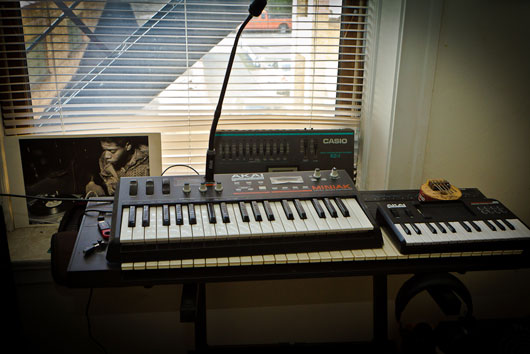
XLR8R: Considering your reputation for analog sounds, it’s surprising to find a computer in here.
Hieroglyphic Being: When I want to send sound files to people who are interested in buying material, I’ll digitize it. My old VCR is busted, but I used to record to VHS tape, just, like, eight hours of analog sound. Then I would take it and put it to Minidisc. Just recently, I started putting it to this Boss Digital Recorder; it does four-track, 32-track, all that stuff. I’ll hook it up and start laying stuff into it. Usually what I do is practice all day and when I know what I want to do, I lay it down in real time. I’m not into that sequencing stuff and then messing around. I just practice it for a bit and then lay it in one take.
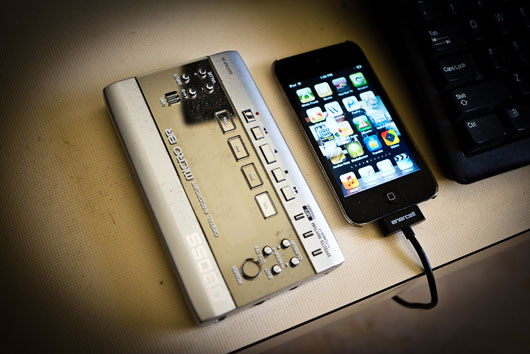
That’s how you work 100% of the time?
Until recently, it was half and half because I was still using my VCR. I slowly started changing over because people from labels were saying, “we like what you do,” but then they’d keep talking about the sound quality. I’m like, I do stuff to VCR. That’s been my thing for a long time. I couldn’t afford DATs and ADATs and CD burners. You gotta realize, you have VCRs that came out in the ’80s and early ’90s that were $600 or $700. Now, you can go to a resale shop and get them for $5. It’s the same thing as ADAT, but the ADAT just has all those compressors and all that new digital technology. So that’s all I use computers for, basically just to save stuff. I’ve got CD-Rs, Minidiscs, VHS tapes, and cassette tapes. I’m running out of space, so I have to go digital. I’ll get up, sit down, and write a couple of hours a day, and just lay stuff, dump it over [to a hard drive], then start over again.
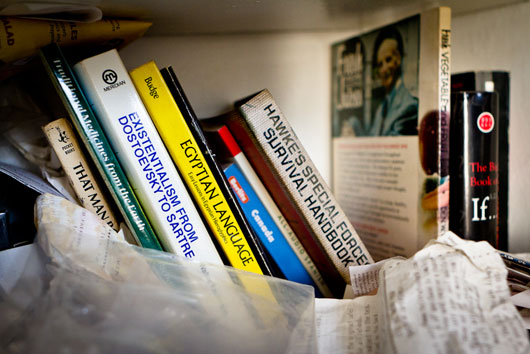
Given your proximity to your work, are you writing new material daily?
Look around—I just roll out of bed and get to it.
Is there a particular machine that you start with?
I build around patterns that I put on my [Boss Dr. Rhythm] DR-5 and then I’ll mess around with my Korg DW-8000. You can generate 303 sounds and everything with it because it has different patches. I’ll get some concepts and then I’ll say, “Okay, I need to find something closer to the sounds in [my Akai Mini-AK],” because sometimes [the Korg] glitches and pops. I need to get it repaired, so I found a machine that has some of the same sound generation. This Akai does it. It’s a professional vocoder, but it has a lot of other stuff in there as well. I also have this [Akai Synth Station 25], it’s a mini version of my other Akai. I’m not trying to take that on the road and get it broke, so I got this [Synth Station 25]. It can do all [the Mini-AK] can do, but I run it with my iPod [Touch]. This little thing is actually more powerful because of the iPod and all the apps you can get for it. People freak out when I go overseas because I bust it out with my drum machine, and they’re like, “Where’s the rest of it?”
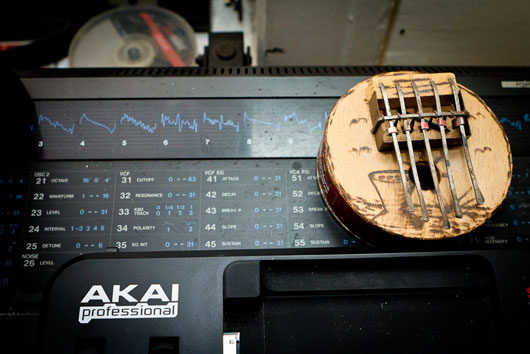
Those two pieces are all you take on tour?
That’s it. I have analog and the whole digital thing and when I put them together, it’s nice. You’ve got to realize, you don’t need to bring out all your tubes and your compressors because the way the clubs are set up now, they already have all the top-of-the-line gear hooked up to the soundsystem. You can work with the sound engineer to get the sound atmospheres where you want them to be. You can get your fat bottom end. You can get your smooth, crisp highs, and your warm mid-range. For me, I feel comfortable with this.
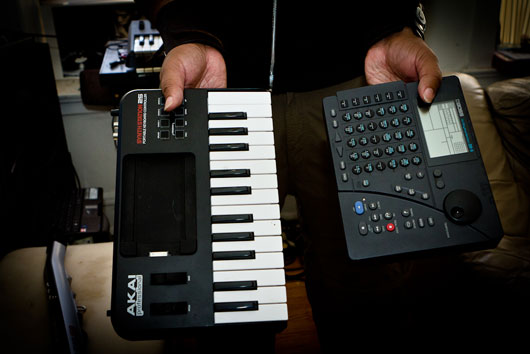
Is the Akai thing a brand preference?
Everybody else has their thing, so I figured I had to find something else that people don’t like too much, that they see as a toy. People don’t see Akai as a brand that measures up to a Moog or a Korg or Roland products. Akai is down the totem pole, and I’m not at the top of the pole, so I’m going to work with the underdog.
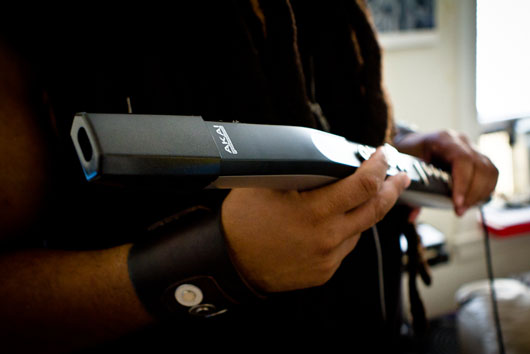
Tell us about your electric horn.
The EWI. Technically speaking, I can do a lot of wind instruments with this thing, but I can also hook it up to my keyboard and trigger sounds with it. I can sit there at a show and do a 303 with this. People say don’t be afraid, so I’m going to bust this out. I can’t just walk in with a laptop and be like, “Woo, look at me.”
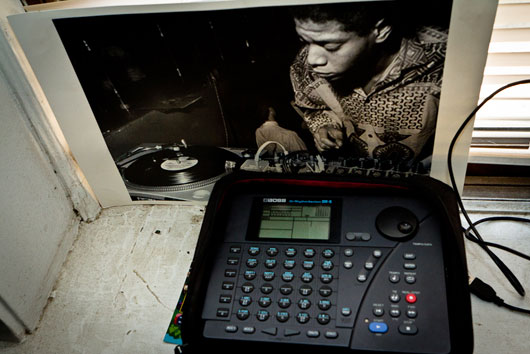
How long have you had that DR-5?
Since ’95. You know, people act weird towards me because they feel like I’m trying to be different and not fit in, but that’s how I’ve been all my life. I just do it my own way and this has 909, 808, 303 sounds. It’s got orchestra sounds; it’s like a band in a box.
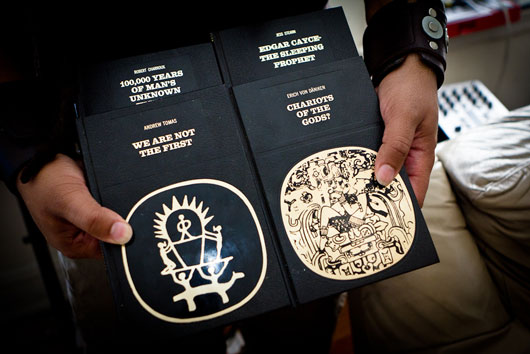
How much has your set-up changed since the ’90s?
I have the drum machine that Steve Poindexter’s “Work that Mutha Fucker” was made on. Before, I had an E-mu Drumulator, an Orbitron, and I had a Korg DDD-1, that was about it. When I feel like I’ve done enough with a certain unit, then I go a different direction and challenge myself. I don’t get it to prove to somebody that I have hot studio gear. I might not touch the DR-5 for a couple months because I’m focusing on this [Synth Station]. Or I might sit around and say, “I’m just going to work on some ambient soundscapes with the Korg.” It just depends on what I’m feeling at the moment. These are my therapists. So maybe this particular therapist can’t help me, but maybe that therapist can.
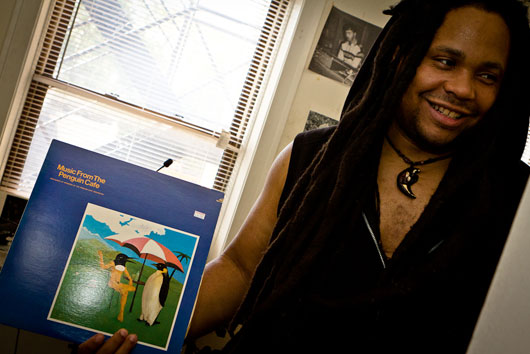
What have you been working on lately? There’s a lot of ambient stuff on your SoundCloud.
I’m going back to where I started: ambient soundscapes, industrial soundscapes, art noise. That’s what I’ve been gravitating to. I’ve been finding movie soundtracks lately, like Doctor Zhivago. If you want to do ambient stuff or static noise, soundtracks are good because of the timing, the tone, the texture, and the emotion. That’s what’s been inspiring me, and what you heard on my SoundCloud page, believe it or not, eight out of 10 of those tracks were done just through my iPod [Touch]—all just with my voice. There’s an app on there you can take and use your voice and change it to sound like synths or strings or whatever.
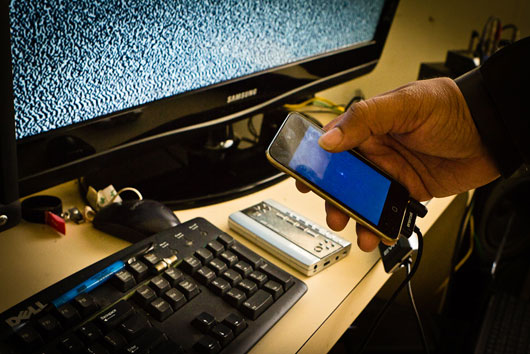
Can you tell us more about some of these apps?
I have NanoStudio, FunkBox… I have this other one, XENON, and then I’ve got a recorder if I want to get field recordings. I have so many of these apps that I’ve been geeking on—ImproVox is also one, it’s like a theremin. I’m giving all my secrets away, I’m going to have to switch up after this. You know cats be pissed off when they’re walking around with all their FX boxes and I walk up with an app.
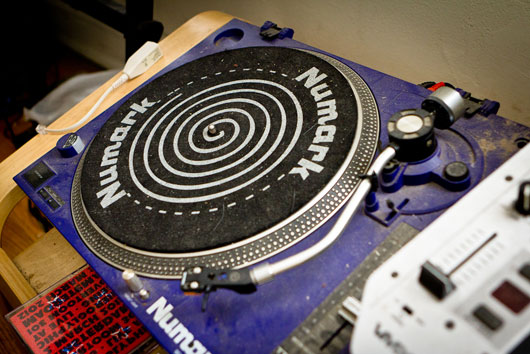
How much collaboration do you find yourself doing?
For a lot of the projects that come out on my Mathematics label, I actually sit there and listen to tons of demos. The ones I think have potential, I will tell them what they need to do. A lot of artists on the label, I work with them. It’ll be months before a record comes out because I’m helping them go the direction they need to go. Sometimes I get tired because it takes away from me doing my thing.
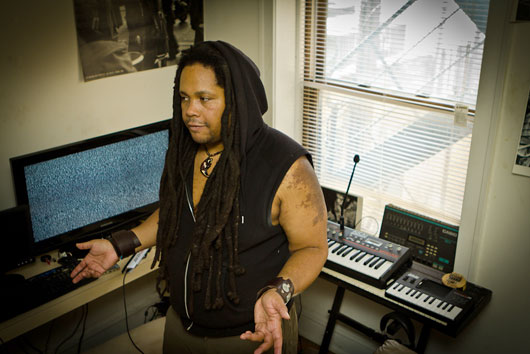
Do you have any sort of musical philosophy that you’re trying to maintain?
I learned from Adonis, one of my mentors, [to not] go chasing what everybody else is doing. Just do what’s comfortable for you. You could go broke trying to get one piece of equipment, when you could be using that money to put out vinyl and get that stuff that [you] already have created out to the masses. Sometimes you don’t need to rush to get to certain things. If you’re chasing [one person in particular], that medium might work fine for them, but it might not be meant for you. At the end of the day, I do what I do to bring positivity through my art and help better the world. Creativity is the most positive thing I can do. This is my redemption.

